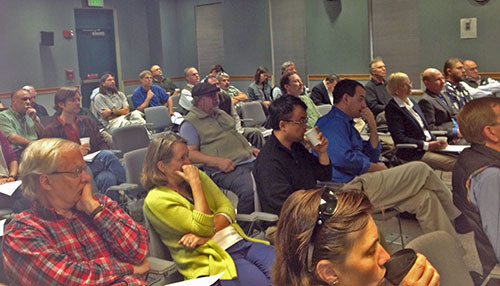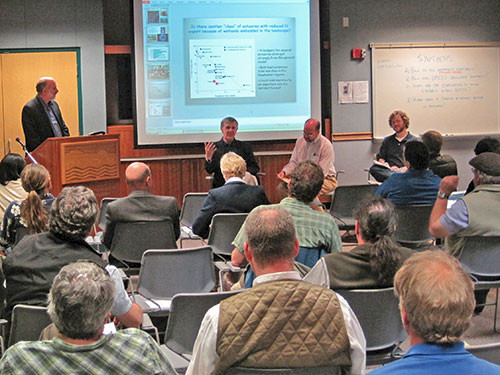Scientific synthesis at the University of Maryland Center for Environmental Science: Part 2--Faculty discussion about creating a 'Synthesis Addiction'
Bill Dennison ·This post is part two of a four part series on scientific synthesis.
At our annual UMCES Faculty Convocation organized by the Appalachian Laboratory faculty senators Drs. Katia Englehardt and Matt Fitzpatrick, we discussed scientific synthesis and asked ourselves the following 4 questions: 1) How do we approach synthesis?, 2) How does UMCES facilitate synthesis?, 3) What are the challenges to doing synthesis within UMCES? and 4) What needs to change to become better in synthesis? We had Drs. Walter Boynton, Keith Eshleman and Mike Wilberg lead this discussion with the UMCES faculty, with Bill Dennison facilitating. The results of this discussion are summarized here.

1) How do we approach synthesis?
Walter Boynton addressed the question of how to approach synthesis with an example in which the nitrogen loading rates of different estuaries were compared by an interdisciplinary team. The ecologists and hydrologists generated the loading rates, but it was the physical oceanographers who developed a relationship with residence time that created an important insight (Nixon et al., 1996). Walter also emphasized the importance of 'positive criticism' in which ideas were not squashed and a team effort is generated. He provided additional examples of follow on analyses and publications that stemmed from the original synthesis effort (e.g., Fisher et al., 2006). Walter pointed out that the rich data resources in the Chesapeake region have been underutilized. He also stressed that synthesis is needed to address the complex issues in coastal regions like anoxia/hypoxia and harmful algal blooms while land use changes and climate change are being manifested. Walter has done such a great job of employing synthesis throughout his career that Bill Dennison's short answer response to the question "How do we approach synthesis?" is simply "Emulate Walter". As a footnote, Walter's long time collaborator Michael Kemp could not attend the convocation due to knee surgery, but he would have been included in the emulation statement.
In discussing the approach to synthesis, several points emerged. The power of doing interdisciplinary synthesis was reiterated, but the value of doing synthesis within a discipline was also stressed (ala Sidauskas et al., 2009). For example, both Keith Eshleman and Mike Wilberg recently completed disciplinary syntheses in atmospheric nitrogen deposition affects on forest stream nitrate and Chesapeake Bay oyster abundance, respectively (e.g., Eshleman et al., in review; Wilberg et al., 2011). The methods of creating immersive opportunities using both in person and virtual meetings were discussed. The importance of having good data sets and rigorous data analyses was emphasized. The technique of developing comparisons was also cited as a powerful synthesis approach.
2) How does UMCES facilitate synthesis?
Keith Eshleman addressed the question of how UMCES can facilitate synthesis by emphasizing the approach that doing synthesis was simply part of doing science. Keith pointed out that he only began doing synthesis in earnest when he was a mature scientist, but that provoked a discussion of whether or not synthesis could be done by less mature scientists. The value of involving young scientists in synthesis was noted, but maturity is often needed for researchers to extend their thinking beyond their research experiences and disciplines. The strategic job hires employed by UMCES to recruit scientists who had both the technical and social skills to be good synthetic scientists was also noted. A distinction was made between a literature review (e.g., the introduction of a thesis/dissertation) and a synthesis in which new patterns and paradigms emerge. Keith emphasized the academic freedom provided by UMCES allowed for synthesis opportunities. An often overlooked aspect of scientific synthesis is that it can be FUN. The piecing together of disparate data and the revelations that can emerge from synthetic analyses can be exhilarating. These positive feedbacks can make synthesis efforts immersive and all-consuming.
3) What are the challenges of doing synthesis at UMCES?
Mike Wilberg talked about the importance of using models, from conceptual model frameworks to mathematical models, in developing synthesis. He also emphasized the astonishing amount of data that is available both within UMCES and in the broader scientific community--often not properly archived or readily available. Mike gave examples of when he was criticized on proposals in which the time he had allotted to doing synthesis without new data creation was not valued. The tradeoffs of generating several standard research papers vs. one synthesis paper, in terms of time and effort, were discussed. The increased impact factor of synthesis papers partly countered the numbers of papers, and the relative ranking of being a lead author on a synthesis effort vs. someone along for the ride further emphasized the importance of 'quality' vs. 'quantity'. The reward systems for synthesis and institutional support for conducting synthesis need to recognize these quality vs. quantity distinctions.
4) What needs to change in order to be better at synthesis?
This discussion, led by Bill Dennison, came up with several specific recommendations, as well as some general principles. The recommendation of using small seed money grants to initiate synthesis efforts was seen as a way to foster the collaborations that could lead to synthesis proposals and papers. A recommendation for quantitative training in synthesis techniques (e.g., statistical analyses, meta-data analyses, spatial analyses) for faculty staff and students was made. The goal of developing a synthesis course was discussed as an important goal, with an initial effort to develop a course initiated by Michael Kemp and Walter Boynton as a MEES seminar in the 2013 fall semester. The use of in person gatherings using central locations like the UMCES Annapolis Office/SESYNC or IMET in Baltimore, combined with virtual sessions using interactive audio or audio-visual approaches was suggested as well. Bill Dennison noted that in developing scientific applications, there is a heavy reliance on scientific integration as a precursor to application, thus the Integration AND Application Network naming convention. He pointed out the many examples of scientific integration (e.g., IAN Press).

Overall, the discussion on scientific synthesis proved to be fruitful and it will continue to be a central part of UMCES. The emphasis in the discussion was on how to do synthesis better and more often, not on whether or not it was worthwhile or needed. Although said in jest by Walter Boynton, the concept of developing a 'Synthesis Addiction' within UMCES was embraced. The entrainment of senior as well as younger scientists into the discussion was also encouraging. It was also highlighted that a similar discussion on science applications would be a worthwhile topic at next year's UMCES faculty convocation.
References
Eshleman KN, RD Sabo, KM Kline. In review. Surface water quality is quickly improving due to declining atmospheric N deposition resulting from U.S. NOx emission controls.
Fisher TR, JD Hagy, WR Boynton, MR Williams. 2006. Cultural eutrophication in the Choptank and Patuxent estuaries of Chesapeake Bay. Limnol. Oceanogr. 51: 435-447.
Nixon SW, JW Ammerman, LP Atkinson, VM Berounsky, G Billen, WC Boicourt, WR Boynton, TM Church, DM Ditoro, R Elmgren, JM Garber, AM Giblin, RA Jahnke, NJP Owens, MEQ Pilson, SP Seitzinger. 1996. The fate of nitrogen and phosphorus at the land-sea margin of the North Atlantic Ocean. In: Nitrogen Cycling in the North Atlantic Ocean and Its Watersheds, Ed. RW Howarth, pp. 141-180.
Sidlauskas B, G Ganapathy, E Hazkani-Covo, KP Jenkins, H Lapp, LW McCall, S Price, R Scherle, PA Spaeth, DW Kidd. Evolution 64: 871-880.
Wilberg MJ, ME Livings, JS Barkman, BT Morris, JM Robinson. 2011. Overfishing, disease, habitat loss, and potential extirpation of oysters in upper Chesapeake Bay. Mar. Ecol. Prog. Ser. 436: 131-144.
Authors
Bill Dennison, Walt Boynton, Katia Englehardt, Keith Eshleman, and Mike Wilberg
About the author
Bill Dennison

Dr. Bill Dennison is a Professor of Marine Science and Vice President for Science Application at the University of Maryland Center for Environmental Science.

